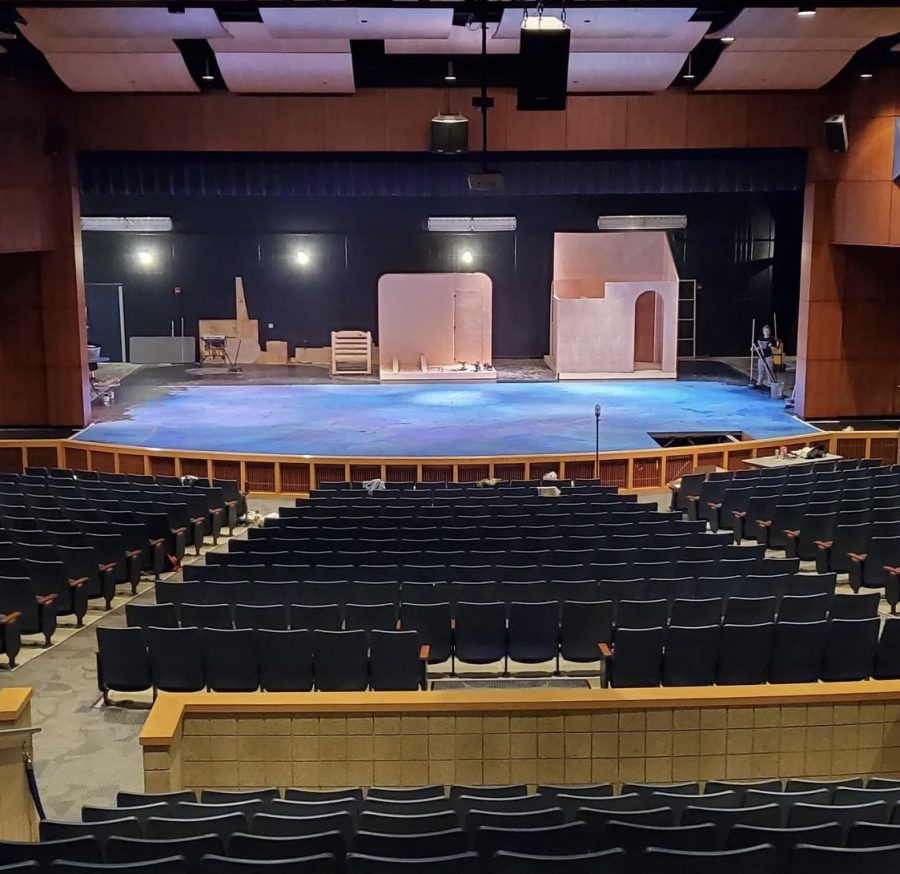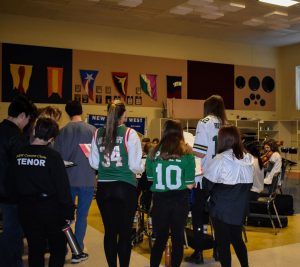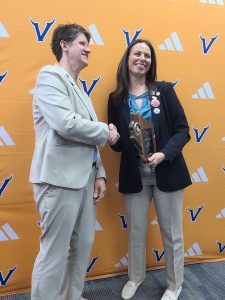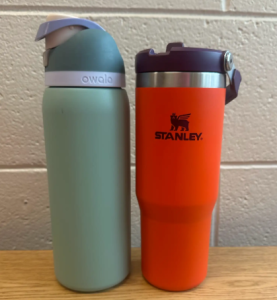Mamma Mia Musical Madness: Behind-the-Scenes of Mamma Mia!
February 2, 2022
Mamma Mia, here we go again! West TAP [theater arts program] has begun preparing for their upcoming musical and Honey, Honey they couldn’t be more excited. The program won’t be running this production as they traditionally do since it is being produced under a new director, Kate Sarner. Before the team can bask in the spotlight they need to get to work putting the musical together. Lights, camera, action!? More like lights, sound, construction, blocking, vocals, costumes… you Mamma Mia is a jukebox musical, a show inspired by existing music. The musical was based on pop songs by ABBA, a Swedish band that grew popular in the 1970s. Here is a look at all the hard work of Mamma Mia coming together.
Workshops
Preparation began by scheduling workshops for students to participate in. The first one, held on October 25th, worked on vocals. Not only was it meant for students to learn the music but also give them insight on how to sing for an audition. They worked in the PAC where Sarah Lemon, New Berlin West’s choir teacher, was there to help.
The second workshop, scheduled on October 26th, focused on choreography. Amanda Rosemann, who works at Skylight Theater in Milwaukee, helped consult on choreography for auditions. She had taught students two different dances to four different songs.
Dan Tiwari, a sophomore cast as Sky, talks about the workshops. “There was Zorba, which was a traditional Greek dance and then we took that same dance and put it to Waterloo, which is an ABBA song… and so we did both of those dances in the audition. Then we also practiced the hustle to the normal hustle song and then to Dancing Queen.”
After the dance workshop, Madisen DeBord, stage manager and choreographer, held an extended dance workgroup where students who felt comfortable practiced more difficult exercises and showed off their individual talents.
Auditions
Vocal auditions were a week after the workshops on November 1st and 2nd. They were done differently this year as each student auditioned privately. This meant only Kate Sarner, Amanda Rosemann, Sarah Lemon, and Madisen DeBord were in the room.
Mara Barczak, a senior cast as Sophie, shares her preparation for her audition. “I listened to the soundtrack nonstop for years, starting when I thought we would be doing this show in 2020. However, when it came time for the official audition, I was singing every day in my bedroom with my sheet music, at my voice lesson, during any flex or study hall or lunch I had available.”
One at a time, students auditioned in the little theater while everyone else waited in the lunchroom for their turn. In the audition, they were told to introduce themselves and share what song they selected to sing. Then staff would ask any other questions they had on the student’s resume before having them sing through their song.
“They’d give you pointers and notes and you’d either sing it the whole time through again or up to a certain stopping point, and that was pretty much it,” Tiwari said.
For dance auditions, students were placed in groups to be seen doing the workshopped dances. Some were asked to come back and dance multiple times till the directors had seen what they needed.
Sarner recorded all of the auditions so when the staff met to choose the cast, they were able to rewatch the videos. From here, they organized callbacks to start putting people together on stage with the material. Auditions allowed them to see people’s individual talent, and callbacks let them see who had chemistry. These are both important factors in the final casting decision.
“[Casting] is a really hard, really complex process,” said Sarner. “So I think there are actually a lot of misconceptions about casting. Casting is really about putting a puzzle together.”
Rehearsals
Once the cast was listed, rehearsals started right away in November. Practices were held every day from 3 pm-6 pm and actors worked on vocals. To get their voices ready, they started each rehearsal with warm-ups.
Ryan Bartley, a junior cast as Sam Carmichael, shares the importance of them. “To physically get yourself warmed up, but also to get into the mind of the character,” he said.
Lemon also explains some of the vocal techniques the actors used doing rehearsals. “Sirens to wake up the whole vocal register as well as vocal range warm-ups to have low and high notes ready to sing songs. We also add movement to vocal warm-ups to have our breath connected and energy awake for this fun musical.”
Actors received sheet music with what they would be singing for the show. Depending on their role, parts were already labeled for some of them. This production also consists of a large ensemble, which means every student will be singing most of the music.
When learning new songs, actors may start by listening to the piece once. Then they begin breaking down harmonies while singing around the piano, to allow them to layer the parts.
In December and January, actors have received more tasks to practice. These include not only learning the music, but also memorizing lines, blocking where actors are positioned on stage, and choreography.
Kelsey Fleckenstein, a senior who is cast as Donna Sheridan, shares her excitement with rehearsals. “The choreography is the best we have ever had in a show and the moves that Mrs. Sarner and Madisen have us doing really pertain to the underlying themes in the story. Some of the dance moves they implemented I had never done and it was really exciting to see what I can actually do dance-wise.”
During rehearsals, DeBord is in charge of making things run smoothly. Her responsibilities as stage manager involve coordinating schedules, writing down all the blocking, giving actors breaks, and teaching the choreography.
She also writes down all of the notes to make sure if actors have questions, she is there to help. “You’re in charge of knowing the whole show basically,” DeBord said.
Each day, the actors work on something different. Rehearsals might consist of vocals one day and choreography the next. Depending on what they rehearse, actors who aren’t in particular scenes on stage are called into different groups to practice things like character work.
Actors have spent downtime during rehearsals building their super-objectives. These are goals built upon the background/character arc they constructed for themselves. This involves seeing how they connect with them, as well as having an understanding of what their character represents.
Mitchell Anderson, a junior who plays Harry Bright, shares what he did to build up his super-objective. “What I did to find my super-objective was to look at all the given information about the character and use that to find the core reason of why he does what he does. I decided that Harry’s main goal throughout the show is to redefine himself as a person and to connect with the person he once was as well as who he is now.”
At the end of rehearsal, the whole cast comes together to review what they learned that day. Then they are given a quick preview of what is to come. Choreography is also videotaped so the actors can watch practice outside of rehearsal.
Barczak mentions how rehearsals have been going. “We’ve had our ups and downs and a fair share of people out, but we have a really good community and a group of passionate kids who work hard no matter the circumstances,” she said.
Costume Design
Lisa Quinn, who has known Sarner for many years, has been asked to help with costume design. She started prepping costumes months in advance, so when she met up with the director, they talked about color schemes and specific things they would like for the show.
After the meeting, she began reading the script to have a concept of the time period. “Then I make a Google Slides look book and drop on a lot of pictures- or sometimes a Pinterest board for ideas,” Quinn said.
Just like other productions have done in the past, students are typically told to bring in undergarments, tights, and shoes. Since Mamma Mia is a contemporary show, they will also be asked to bring in certain costume pieces to fit their character. As for Quinn, she is mostly bringing in costumes from another theater she worked at. While extra pieces will have to be bought from thrift stores or be personally made.
Actors had a costume parade on January 22. They tried on clothes selected for them as well as their own. This lets Quinn mark any alterations that are needed and know what items are missing for tech week.
Quinn’s favorite part of working on Mamma Mia “is the last day of tech when I get to sit in the house, almost by myself, and get to watch the cast put on their show,” she said.
Pit
Thank You for the Music because we can’t forget about the instruments. Pit, another factor contributing to the musical, is where musicians come together and play their instruments in sync with the actors. New Berlin West’s pit consists of only high school students.
The conductor for Mamma Mia’s pit is New Berlin West’s orchestra teacher Mrs. Stephanie Keller. She is thrilled to work with both full instrumentations and voices. “Mamma Mia is such a fun show and I’m so excited to be a part of it!” Keller said.
Google forms had been sent out by the music teachers as well as posted on their canvas pages to see who was interested. Students filling out the form were asked for their names, the instrument they play, and time availability. This allowed Keller to understand who wanted to be involved and create a schedule.
Mamma Mia the musical was originally only written for guitars, keyboards, drums, percussion, bass, and a drum set. “We’re getting creative and finding ways to cover all of the keyboard parts with live instrument sounds (strings, brass, winds) to involve more of our students in this show,” Keller said.
Once all of the instrument parts were made, rehearsals started off voluntarily. Practices were scheduled during flex every Wednesday and Friday in the orchestra room. Upon flex rehearsals, students began sight-reading the music, listening to the broadway soundtrack for comparison, and going through sections of the songs.
As it has gotten closer to the performance, Keller requested after-school rehearsals, to construct more time for musicians to play together. These began January 3rd on Mondays and Tuesdays from 3:00 pm-4:30 pm.
Chelsea Yu, a senior playing the violin, describes a challenge with the pit. “The music is typically difficult to play, which is the fear for many musicians. Also, because there are many musicians, it is a challenge to play together.”
With a three-week tech week, the pit was scheduled for a band view on January 18th in the PAC. This gives the musicians a chance to watch the show and know their involvement. After the pit watched the show, they began working with the actors.
Both pit and cast rehearsed together in the orchestra room. The first few days, from 2:50 pm-6 pm, they ran through the entire show to see how it went. This allowed them to know what sections of the musical needed more in-depth practice for the next rehearsal.
Amy West, a senior playing the flute, shares her excitement about being a part of the pit. “It’s an amazing experience being a part of something that feels so small most of the time in rehearsal, but it’s incredible and so much fun when everyone’s hard work in the production comes together and everything just clicks.”
A different aspect of the show is the pit will be gathered on stage, behind a screen, rather than under. They will have approximately 15 ft of space on stage and the audience will be able to see them through parts of the production.
Set and Tech
Preparation for the set and tech is being helped by designer Andy Armstrong. The design starts with the director’s vision and how she interprets it. Once the vision is determined, elements of tech are supported in the show. This is when the crew understands what needs to be done.
When working with a high school set, Armstrong believes “it works best when the crew heads are active and involved from the early design phases.”
Including the crew solves two potential issues. The first one is, if the vision is bigger than expected, it is easier to build the set. “Second, a better understanding of the vision allows for better diversity of thought,” Armstrong said.
Students from New Berlin West are participating in the crew. Wednesdays and Thursdays, after school, were available for students to start building. Saturdays have also been open, from 9 am-5 pm, for extra time to get the set ready for the show.
For the tech aspect, Leo Wagner, a student at New Berlin West, is excited to work with sound for the show alongside Owen Fink. Wagner has worked with sound for almost every show he has participated in and he feels most comfortable with it.
Jack Schneider, another student at New Berlin West, is going to work with lighting for this production. This will be his first time doing lights for a musical as opposed to a play.
Schneider shares differences in how Mamma Mia is running set and tech. “We are building a set in a style that we haven’t really ever done before that you’ll have to see at the show. Other than that, simple changes to things like lighting and stage management.”
With more staff involved, they will be up in the booth, a room built above the auditorium for technical elements. This will give the crew more guidance through the performance.
West TAP has worked hard during these past months to be fully prepared for the musical. DeBord has finalized choreography for the actors while they are putting their costumes together. Rehearsals still consist of working with the pit and running through the show to make sure everyone is in sync.
The crew has wrapped up building the set, which is put on stage when needed for a scene. Actors now have a better understanding of their blocking and the pit has the space to be put on stage.
Individuals participating in tech have learned calling cues to know their responsibility during the show. Incorporating these technical elements contribute to making the musical successful.
When All Is Said and Done Mamma Mia will be performing on February 4th and 5th at 7 pm and the 6th at 2 pm.






